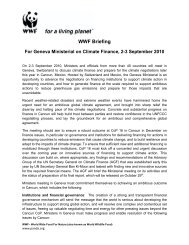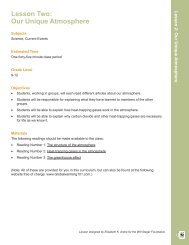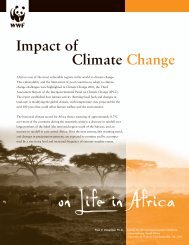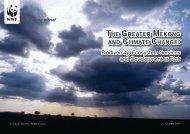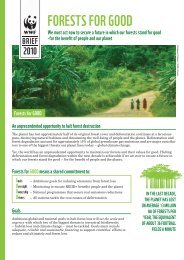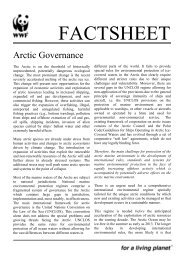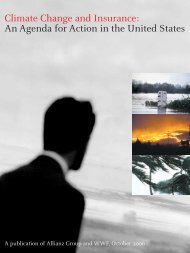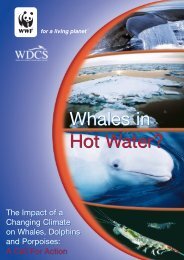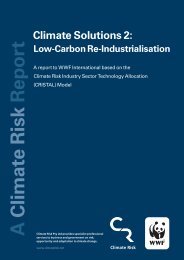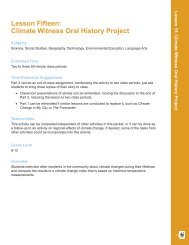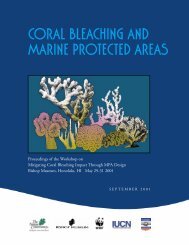1.0 Mangroves: Values, Status <strong>and</strong> ThreatsFactor Processes affected Impacts ReferencesRising sea level- Forest health- Forest productivity- Recruitment- Inundation period- Sedimentation rates- Forest mortality, dieback from theseaward edge- Migration l<strong>and</strong>ward, but dependenton sediment inputs, topography<strong>and</strong> human modificationsEllison, 1993, 2005; Semeniuk, 1994;Cahoon et al., 2006; Gilman et al.,2008; Soares, 2009Extreme storms- Forest productivity- Recruitment- Sedimentation rates- Forests damaged or destroyed- Ground elevation change- Erosion or sediment smotheringJaffar, 1992; Dahdouh-Guebas et al.,2005; Alongi, 2008; Yanagisawa et al.,2009Increased waves<strong>and</strong> wind- Sedimentation rates- Recruitment- <strong>Change</strong>s in forest coverage, dependingon whether coasts areaccreting or erodingSemeniuk, 1994Increased air <strong>and</strong>sea temperature- Respiration- Photosynthesis- Forest productivity- Reduced productivity at lowlatitudes <strong>and</strong> increased winterproductivity at high latitudesClough & Sim, 1989; Cheeseman et al.,1991; Cheeseman, 1994; Cheesemanet al., 1997Enhanced CO 2- Photosynthesis- Respiration- Biomass allocation- Forest productivity- Increased productivity, subject tolimiting factors of salinity, humidity<strong>and</strong> nutrients- Soil elevation gainSnedaker, 1995; Farnsworth et al, 1996;Ball et al., 1997; Langley et al., 2009UV-B radiation- Morphology- Photosynthesis- Forest productivity- Minor Lovelock et al., 1992; Day & Neale,2002; Caldwell et al., 2003Increased rainfall- Sediment inputs- Ground water- Salinity- Productivity- Increased sediments <strong>and</strong> maintenanceof surface elevation- Increased ground water- Increased diversity- Increased productivity- Increased recruitmentSmith & Duke, 1987; Rogers et al.,2005; Whelan et al., 2005; Krauss etal., 2003Reduced rainfall- Sediment inputs- Ground water- Salinity- Reduced sediments <strong>and</strong> relativesubsidence- Migration l<strong>and</strong>ward- Reduced ground water- Reduced photosynthesis- Reduced productivity- Species turnover- Reduced diversityRogers et al., 2005; Rogers et al., 2005;Whelan et al., 2005; Smith & Duke,1987Reduced humidity- Photosynthesis- Forest productivity- Reduced productivity- Species turnover- Reduced diversityClough & Sim, 1989; Cheeseman etal., 1991; Cheeseman, 1994; Ball et al.,1997Table 1. Predicted effects of climate change factors on mangroves with key references (adapted from Lovelock &Ellison, 2007).4 | <strong>Climate</strong> <strong>Change</strong> <strong>Vulnerability</strong> <strong>Assessment</strong> <strong>and</strong> <strong>Adaptation</strong> <strong>Planning</strong> for Mangrove Systems
1.0 Mangroves: Values, Status <strong>and</strong> ThreatsType Attributes River-dominated Tide-dominated Wave-dominatedGeomorphic settingSediment sourceDeltaicdistributariesEstuarine withelongated isl<strong>and</strong>sBarrier isl<strong>and</strong>s/spits <strong>and</strong> lagoonsRiver- <strong>and</strong> wavedominatedDistributaries <strong>and</strong>lagoonsLow isl<strong>and</strong>Marine-dominatedAllochthonous Allochthonous Autochthonous Allochthonous AutochthonousTidal range Low High Any Any LowMangrove locationsDominant processExamplesSpecific vulnerabilitySeaward edge <strong>and</strong>distributariesFreshwaterdischargeMississippi;Ganges-Brahmaputra;Rufiji, Tanzania<strong>Change</strong> indischarge <strong>and</strong>sediment supplyTidal creeks <strong>and</strong>isl<strong>and</strong>sInside lagoonsLow-energydistributaries <strong>and</strong>lagoonsTidal currents Wave energy Wave energy<strong>and</strong> freshwaterdischargeOrd, Australia;Fly, Papua NewGuinea; Klang,MalaysiaIncreased tidalaction; change insediment budgetsEl Salvador;Mono, Benin;Laguna deTerminos, MexicoIncreased waveaction; change insediment budgetsGrijalva, Mexico;Burdekin, Australia;Sanaga, CameroonReduction insediment supplyFringing or basinSea levelTongatapu;Kiribati; Gr<strong>and</strong>Cayman;Jaluit, MarshallIsl<strong>and</strong>sLowsedimentationratesTable 2. Mangrove geomorphic settings <strong>and</strong> their controlling attributes (adapted from Thom, 1982; <strong>and</strong> Ellison, 2009a).The response of mangrove habitats in differentcoastal locations to climate change will depend on anumber of factors of coastal behavior, including tidalrange, sedimentology, salinity regime, communitycomposition <strong>and</strong> shore profile. Although they areintertidal, mangroves occur in a range of settings thatmay have different vulnerabilities to climate changeimpacts (Table 2).Allochthonous means that there are external sources ofsediment for the mangroves, particularly from rivers.This sediment tends to be inorganic, <strong>and</strong> mangrovesystems that have such sediment supply have highersedimentation rates, making them less vulnerable tosea level rise.Tidal range <strong>and</strong> relative sea level change are keyexposure factors relating to the vulnerability ofmangroves to sea level rise. For example, sea levelrise will have a greater impact on intertidal systems inmicrotidal areas than in macrotidal areas because thetidal zone relocation will be more complete (Figure 3).Global sea level rise will also have a greater impact onareas that already suffer from relative sea level rise dueto deltaic subsidence. Identification <strong>and</strong> interpretationof such vulnerabilities are the objectives of Sections 3<strong>and</strong> 4 of this manual.Autochthonous means that sediment sourcesare primarily organic <strong>and</strong> from in situ mangroveproduction, resulting in peaty sediment. Mangroveswith such sediment supply tend to have lowersedimentation rates, making them more vulnerable tosea level rise. These factors are incorporated into thevulnerability ranking in Section 4.<strong>Climate</strong> <strong>Change</strong> <strong>Vulnerability</strong> <strong>Assessment</strong> <strong>and</strong> <strong>Adaptation</strong> <strong>Planning</strong> for Mangrove Systems | 5
- Page 2 and 3: © 2012 WWFISBN: 978-92-990069-0-0R
- Page 4 and 5: © naturepl.com/Tim Laman/WWF
- Page 6: Table of Contents, Figures8.0 Gloss
- Page 12 and 13: Photo: Monifa Fiu
- Page 20: 2.0 Planning a Vulnerability Assess
- Page 26 and 27: 3.0 Conducting a Vulnerability Asse
- Page 32: 3.0 Conducting a Vulnerability Asse
- Page 36 and 37: 3.0 Conducting a Vulnerability Asse
- Page 40 and 41: 3.0 Conducting a Vulnerability Asse
- Page 42: 3.0 Conducting a Vulnerability Asse
- Page 46 and 47: 3.0 Conducting a Vulnerability Asse
- Page 49: 3.0 Conducting a Vulnerability Asse
- Page 56 and 57: 3.0 Conducting a Vulnerability Asse
- Page 59: 3.0 Conducting a Vulnerability Asse
- Page 64:
3.0 Conducting a Vulnerability Asse
- Page 67 and 68:
3.0 Conducting a Vulnerability Asse
- Page 71:
3.0 Conducting a Vulnerability Asse
- Page 75 and 76:
3.0 Conducting a Vulnerability Asse
- Page 77:
3.0 Conducting a Vulnerability Asse
- Page 80 and 81:
3.0 Conducting a Vulnerability Asse
- Page 82 and 83:
3.0 Conducting a Vulnerability Asse
- Page 84 and 85:
3.0 Conducting a Vulnerability Asse
- Page 86 and 87:
3.0 Conducting a Vulnerability Asse
- Page 88 and 89:
3.0 Conducting a Vulnerability Asse
- Page 90 and 91:
3.0 Conducting a Vulnerability Asse
- Page 92 and 93:
4.0 Interpreting a Mangrove Vuneral
- Page 94 and 95:
4.0 Interpreting a Mangrove Vuneral
- Page 96 and 97:
4.0 Interpreting a Mangrove Vuneral
- Page 98:
5.0 Developing Adaptation MeasuresT
- Page 102 and 103:
5.0 Developing Adaptation Measures5
- Page 104 and 105:
5.0 Developing Adaptation Measureso
- Page 106 and 107:
5.0 Developing Adaptation Measures5
- Page 109 and 110:
5.0 Developing Adaptation MeasuresF
- Page 111 and 112:
5.0 Developing Adaptation MeasuresF
- Page 114 and 115:
5.0 Developing Adaptation Measures5
- Page 116 and 117:
6.0 ConclusionsClimate change, part
- Page 118 and 119:
7.0 ReferencesBosire, J. O., Dahdou
- Page 120 and 121:
7.0 ReferencesForbes, A. T., & Cyru
- Page 122 and 123:
7.0 ReferencesKovacs, J. M., Wang,
- Page 124 and 125:
7.0 ReferencesRogers, K., Saintilan
- Page 126 and 127:
8.0 GlossaryAbscission collar A reg
- Page 128 and 129:
8.0 GlossaryLiDAR Light Detection a
- Page 130 and 131:
Photo: Rob Anders
- Page 132 and 133:
Appendix: Data Sheets120 | Climate
- Page 134 and 135:
Appendix: Data Sheets122 | Climate
- Page 136 and 137:
Appendix: Data SheetsData sheet for
- Page 138 and 139:
Appendix: Data Sheets126 | Climate
- Page 140:
Appendix: Data Sheets128 | Climate



